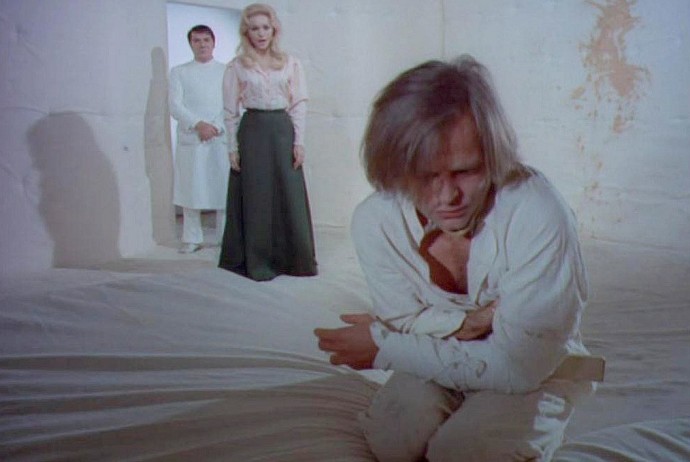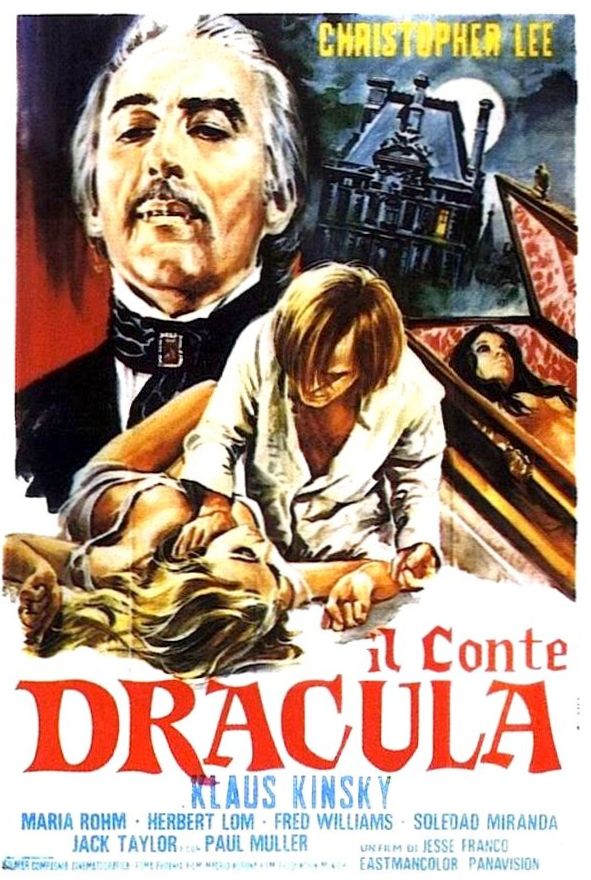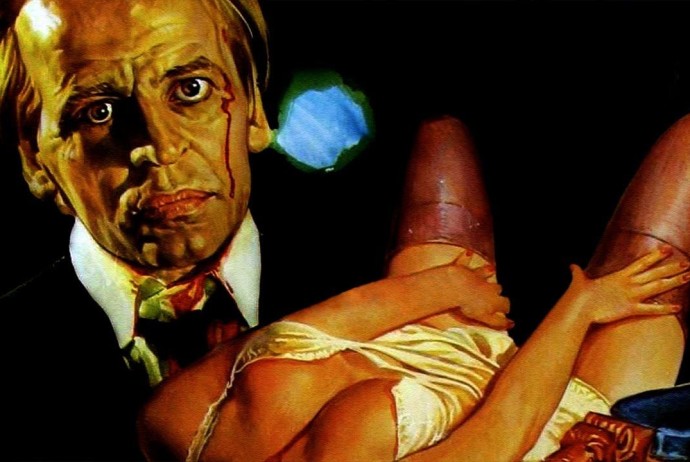Dir: Pasquale Squitieri
Star: Leonard Mann, Ivan Rassimov, Steffen Zacharias, Klaus Kinski
a.k.a. La Vendetta è un piatto che si serve freddo, Vengeance Trail, Three Amens for Satan
While relatively minor in terms of Kinski content – after a brief appearance near the beginning, he then vanishes entirely for the bulk of its running time – this is still solidly satisfying. As an 11-year-old, Jeremiah Bridger (Mann) narrowly escaped being slaughtered, along with the rest of his family, when Indians attacked their Arizona farm. Now grown up, he has vowed to take revenge, and spends his time hunting, killing and scalping any native Americans he can find, selling their scalps to a local wig-maker(!). However, even he draws the line at killing women, and when he comes across one, Tena (Elizabeth Eversfield), takes her back to town.
The local folks don’t take kindly to this, due to a recent spate of Indian attacks, and tar and feather her. Jeremiah temporarily rescues her, only for the worst of the locals, Boone (Teodoro Corrà), to re-capture Tena as a present for his boss, Perkins (Rassimov). Jeremiah is rescued by a conveniently-passing comedic doctor (Zacharias), who spills the beans on what has been going on. Perkins has been staging all the attacks as part of a long-term land-grab, targeting those who stand in his way. He has been using his men, but blaming it on the natives, with the help of local journalist, Prescott (Kinski). It’s time for the end game. Seems like one more “atrocity”, and the Army will clear out all the Indians, freeing up their land – and, more importantly, its water – for use by Perkins.
 Jeremiah heads off Boone and his men on their way to carry out the attack, frees the tribesmen whose corpses are intended to be left at the scene, and heads back to infiltrate his way into Perkins inner circle. For this is where the Italian title comes into play: it translates as “Revenge is a dish best served cold.” And there I was, thinking all the time it was a Klingon proverb. Quentin Tarantino was lying to me! [And it’s not as if a film geek like QT, especially one so devoted a fan of spaghetti Westerns, would be unaware of this one, though the phrase pre-dates the movie, obviously] So, ten years on, it’s time for those who were really behind the murder of our hero’s family, to pay for their crimes.
Jeremiah heads off Boone and his men on their way to carry out the attack, frees the tribesmen whose corpses are intended to be left at the scene, and heads back to infiltrate his way into Perkins inner circle. For this is where the Italian title comes into play: it translates as “Revenge is a dish best served cold.” And there I was, thinking all the time it was a Klingon proverb. Quentin Tarantino was lying to me! [And it’s not as if a film geek like QT, especially one so devoted a fan of spaghetti Westerns, would be unaware of this one, though the phrase pre-dates the movie, obviously] So, ten years on, it’s time for those who were really behind the murder of our hero’s family, to pay for their crimes.
Damn, this does not exactly offer a sympathetic portrayal of Western settlers. Even Jeremiah is first seen as an adult engaging enthusiastically in genocidal slaughter, a firm believer in the notion that “the only good Injun is a dead Injun.” Just about everyone else is on the same page: either actively, in collusion with Perkins, or through believing the lies put out by Prescott in his newspaper. I couldn’t help thinking of the “false flag” claims which have become increasingly prevalent in the more paranoid corners of conspiracy theory lately, since what’s shown here is, effectively, what the government is accused of carrying out at Sandy Hook, Orlando, etc. It’s particularly notable in light of events just a few years later in Italy, where some of the attacks blamed on the Red Brigade, were allegedly actually carried out by right-wing groups.
Removing my tinfoil hat, and replacing it with the more appropriate Stetson… This is a good, relatively straightforward Western, though I was initially confused with the transition between young Jeremiah and the adult version, and didn’t immediately realize they were the same person. Mann makes for a good, taciturn hero, who believes in letting his action speak louder than his words. Those against whom he goes up, are equally appropriate, Rassimov makes a good villain, and Kinski oozes tabloid slime onto the screen in every scene. In particular, check out where Perkins rolls out a selection of kept women (though captive women might be closer), and offers Prescott his choice for the night. I felt like I was watching Shark Week on the Discovery Channel for a moment, watching Kinski languidly circling his prey. It’s the potential for moments like this which make even small Klaus roles worth the effort.
Less effective are the minor roles on the good guy’s side. Doc is a misconceived effort to inject levity into a plot, that doesn’t work at all. He fulfills all necessary purpose after his exposition tells Jeremiah the truth about what’s going on. Eversfield, in her only role, according to the IMDb, is no more convincing as a native American – should that be called “redface”? – spouting pseudo-philosophical nonsense in bad English. The same goes for Yotanka, the family’s Indian friend pre-massacre, who might as well have “noble savage” tattooed across his forehead. I was also not particularly convinced by Jeramiah’s sudden conversion from mass murderer of Indians to their protector. Generally (and I see this all the time with conspiracy theorists), it takes a lot for anyone to accept their deeply-held belief is thoroughly wrong. The cynic in me suggests that Tune must have been a really good lay…
Just to lob in a note on the score, which was composed by Piero Umiliani. He was one of the second tier of go-to guys for spaghetti soundtracks, a little behind Ennio Morricone and Riz Ortolani. But outside of that, he’s probably best known for writing Mah Nà Mah Nà. a ditty originally composed for a mondo film about Sweden, but latter covered on multiple occasions by the Muppets. If only there was a version of the song performed by Kinski, rather than just him doing songs by Bertold Brecht… It would be utterly epic.

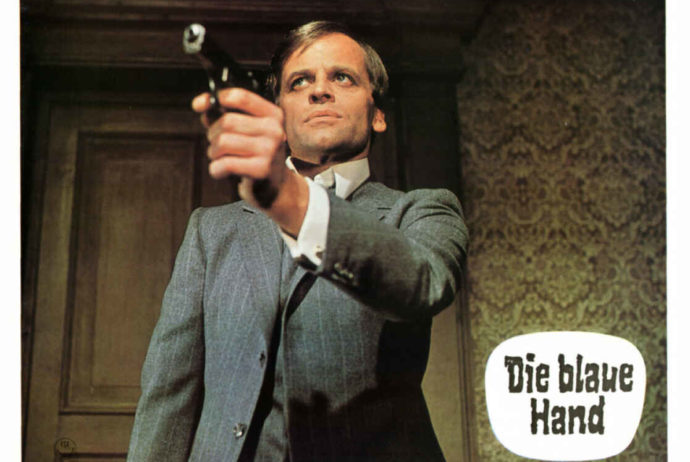
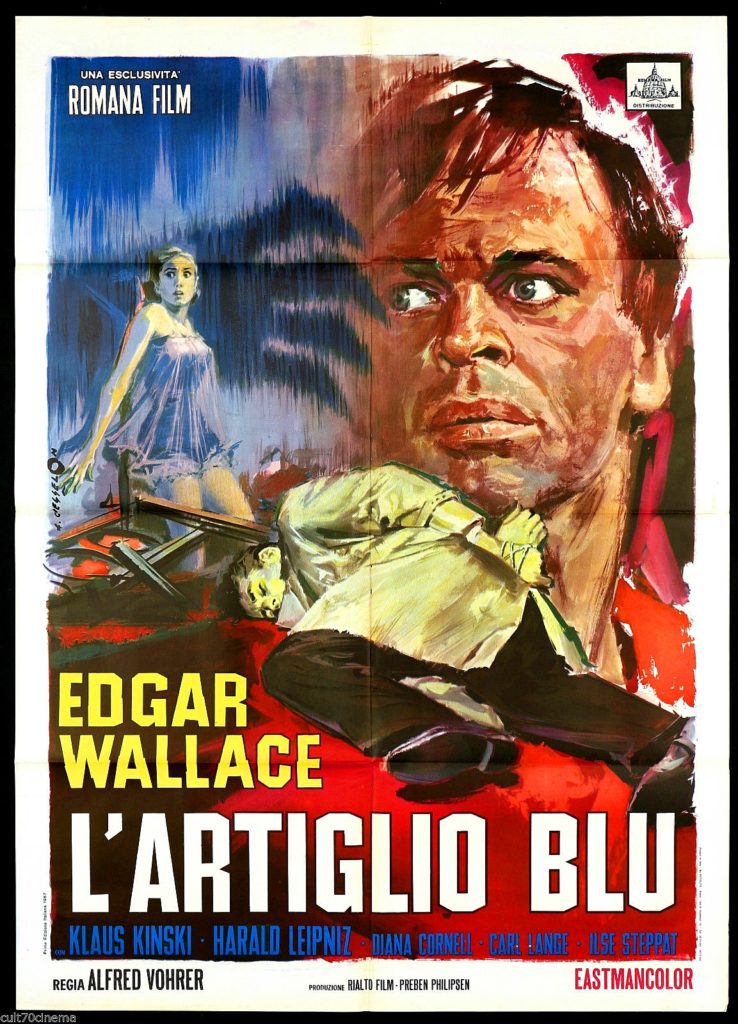 I guess, in 1967, this was edgy stuff. Anyway, back in the impenetrable morass which is the plot, you’d better hold on with both hands, especially in the final 10 minutes when Craig pulls the solution out, with a flourish befitting a cabaret magician finding a rabbit in his top-hat, and about as much logic. Yes, I suppose the culprit could have committed the crimes as Craig alleges; but if I was their defense attorney, I’d be filing for a motion to dismiss based on a severe lack of evidence. It could have been just about anybody. My money’s on Mangrove, mostly because I tend to be suspicious of psychiatrists whose office has a painting, behind which is a hidden snake-cage, the inhabitant of which he uses, for example, to traumatize a nurse who has found out about his nefarious schemes.
I guess, in 1967, this was edgy stuff. Anyway, back in the impenetrable morass which is the plot, you’d better hold on with both hands, especially in the final 10 minutes when Craig pulls the solution out, with a flourish befitting a cabaret magician finding a rabbit in his top-hat, and about as much logic. Yes, I suppose the culprit could have committed the crimes as Craig alleges; but if I was their defense attorney, I’d be filing for a motion to dismiss based on a severe lack of evidence. It could have been just about anybody. My money’s on Mangrove, mostly because I tend to be suspicious of psychiatrists whose office has a painting, behind which is a hidden snake-cage, the inhabitant of which he uses, for example, to traumatize a nurse who has found out about his nefarious schemes.
 Except, naturally, it turns out to be far from deserted, playing home to a wide spectrum of characters – some of whom happen to bear a strong resemblance to portraits hanging on the walls. The first of these to appear is Elisabeth Blackwood (Mercier), for whom Foster falls, and falls hard; this is used to explain his reluctance to leave, once the escalating weirdness achieves full effect. She’s followed shortly after by another, rather more sullen beauty, Julia (Karin Field), and before you know it, this supposedly vacant home is playing host to an entire ball. Turns out, as you have perhaps guessed already, that these are not living people, but spectral entities left over from previous tragic events.
Except, naturally, it turns out to be far from deserted, playing home to a wide spectrum of characters – some of whom happen to bear a strong resemblance to portraits hanging on the walls. The first of these to appear is Elisabeth Blackwood (Mercier), for whom Foster falls, and falls hard; this is used to explain his reluctance to leave, once the escalating weirdness achieves full effect. She’s followed shortly after by another, rather more sullen beauty, Julia (Karin Field), and before you know it, this supposedly vacant home is playing host to an entire ball. Turns out, as you have perhaps guessed already, that these are not living people, but spectral entities left over from previous tragic events.
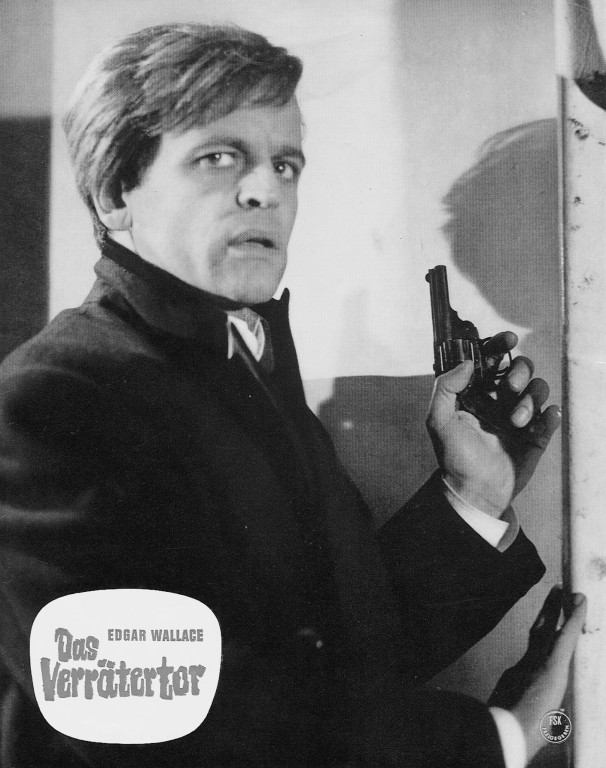 Bit of a surprise to see this is directed by Freddie Francis, an English film-maker, best known for his work as a cinematographer (winning Oscars almost three decades apart, for Sons and Lovers and Glory). As a director, in the sixties he was regularly employed by both Hammer and Amicus, helming Dracula Has Risen From the Grave, The Evil of Frankenstein and 1972’s Tales From the Crypt. Having once said, “Horror films have liked me more than I have liked horror films.” this movie is unusual, both in being German and a krimi, without any supernatural or horrific elements. The screenplay, similarly, was written by another Hammer horror veteran, Jimmy Sangster, based on Edgar Wallace’s
Bit of a surprise to see this is directed by Freddie Francis, an English film-maker, best known for his work as a cinematographer (winning Oscars almost three decades apart, for Sons and Lovers and Glory). As a director, in the sixties he was regularly employed by both Hammer and Amicus, helming Dracula Has Risen From the Grave, The Evil of Frankenstein and 1972’s Tales From the Crypt. Having once said, “Horror films have liked me more than I have liked horror films.” this movie is unusual, both in being German and a krimi, without any supernatural or horrific elements. The screenplay, similarly, was written by another Hammer horror veteran, Jimmy Sangster, based on Edgar Wallace’s
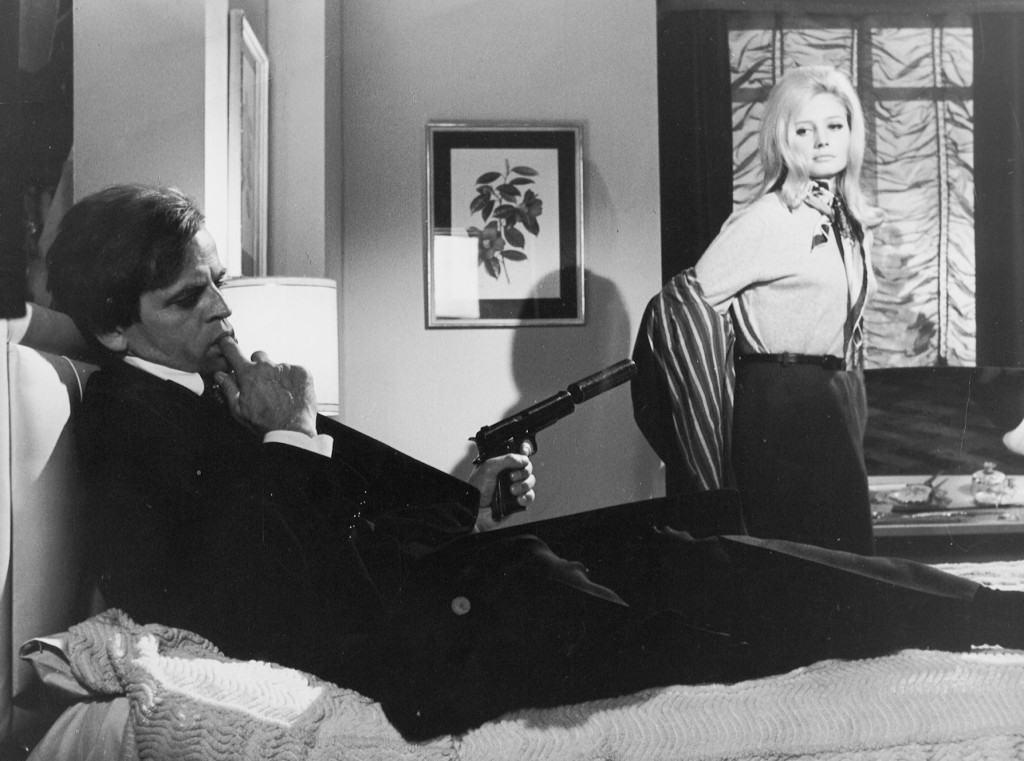

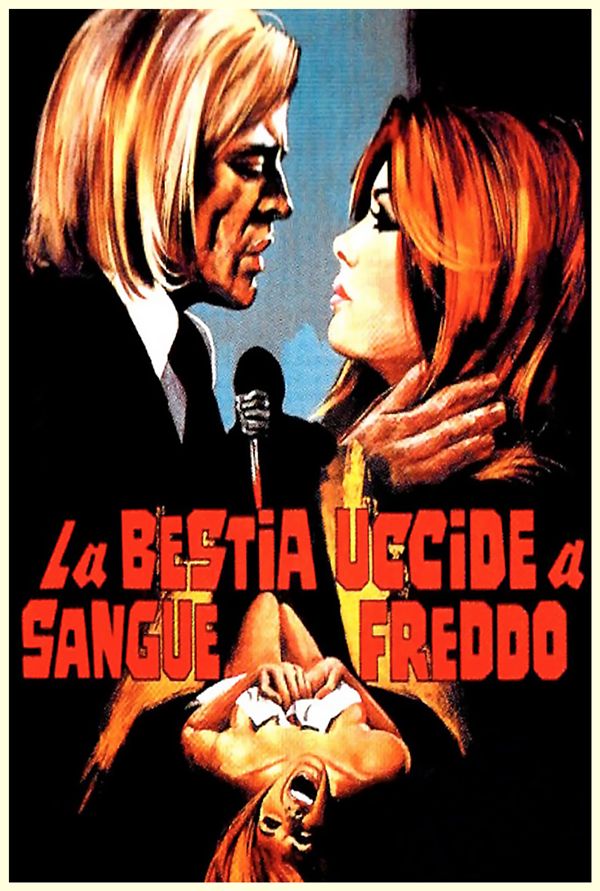 Anyone else, however, will likely find this irredeemably bad, to the point of unwatchable. I’ve seem some truly shitty examples of the giallo genre in my time, yet this one manages to scrape the bottom of the barrel, for its nonsensical plotting and feeble performances, lacking even the strong sense of visual style for which the field is generally renowned. Kinski is entirely wasted, with his doctor getting the absolute minimum of screen time, and the character could have been removed entirely without impacting the film to any significant degree. Di Leo clearly decided, “Why bother having Kinski, when you can have an apparently endless massage instead?” I suppose this choice could be considered as having some kind of artistic vision, except it’s a vision of which I want absolutely no part.
Anyone else, however, will likely find this irredeemably bad, to the point of unwatchable. I’ve seem some truly shitty examples of the giallo genre in my time, yet this one manages to scrape the bottom of the barrel, for its nonsensical plotting and feeble performances, lacking even the strong sense of visual style for which the field is generally renowned. Kinski is entirely wasted, with his doctor getting the absolute minimum of screen time, and the character could have been removed entirely without impacting the film to any significant degree. Di Leo clearly decided, “Why bother having Kinski, when you can have an apparently endless massage instead?” I suppose this choice could be considered as having some kind of artistic vision, except it’s a vision of which I want absolutely no part.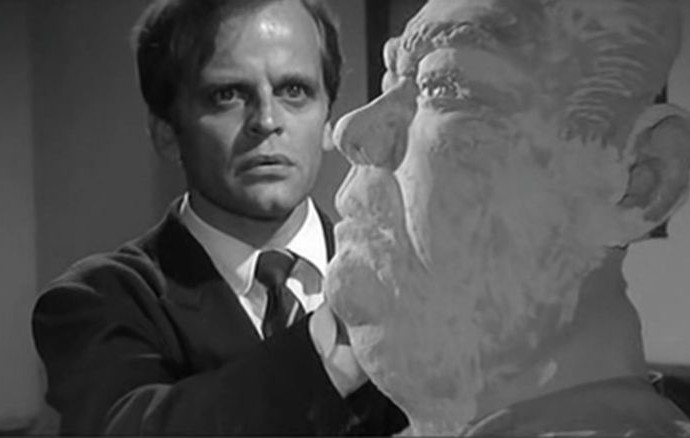
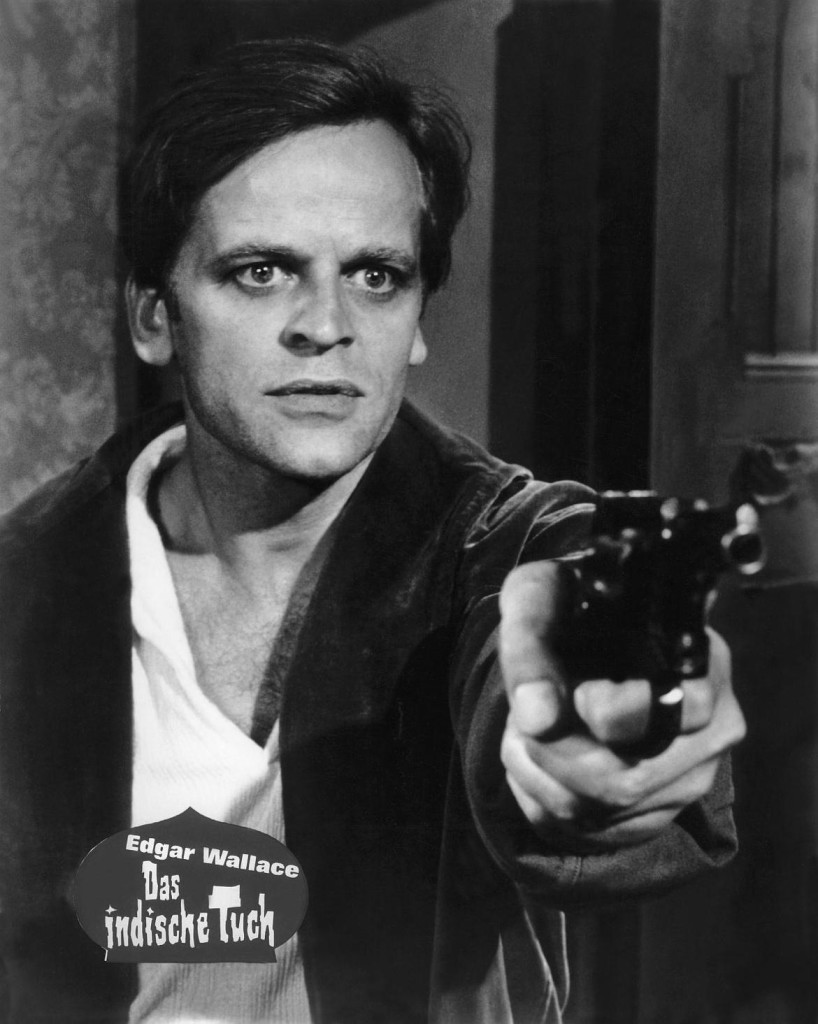 That said, I can’t say, I minded this self-aware attitude, which has probably stood the test of time better than a straight “mystery” approach would have, and largely inoculates the film against some of the more obvious criticisms that could be leveled at it. For example, it’s clearly an extremely cheap production, without a single exterior shot: the closest you get are some very obvious drawings of the manor seen from the outside, with smoke being blown across them. Taken seriously, these would be woeful indeed; instead, they set things up nicely, almost adding to the sense of meta-satire here. The characters here are similarly almost deliberately cliched, stereotypes of the field, running the gamut from the doting mother and her neurotically “gifted” son, all the way to… Klaus Kinski.
That said, I can’t say, I minded this self-aware attitude, which has probably stood the test of time better than a straight “mystery” approach would have, and largely inoculates the film against some of the more obvious criticisms that could be leveled at it. For example, it’s clearly an extremely cheap production, without a single exterior shot: the closest you get are some very obvious drawings of the manor seen from the outside, with smoke being blown across them. Taken seriously, these would be woeful indeed; instead, they set things up nicely, almost adding to the sense of meta-satire here. The characters here are similarly almost deliberately cliched, stereotypes of the field, running the gamut from the doting mother and her neurotically “gifted” son, all the way to… Klaus Kinski.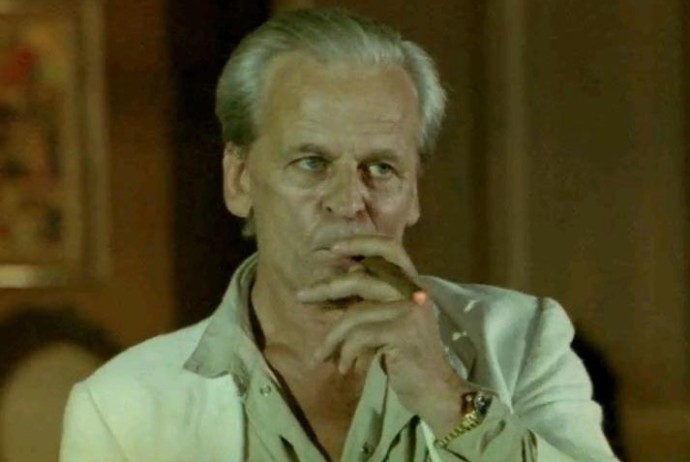
 Thus begins a game of cat and mouse between Silveira and Carrasco, who joins forces with the typical slew of characters you get in movies like this – a foreign mercenary, a Catholic priest (Lehmann), hot local chick Maria (Donadi). Meanwhile, Silveira and his militia forces stop at nothing to paint Carrasco and crew as the bad guys, including gunning down refugees, shooting up a hospital, and even blowing up a plane full of 185 kids and blaming it on the rebels. Damn: even by the standards of psychopathy we’ve come to expect from our #1 German lunatic, that’s cold. Needless to say, this doesn’t stop the revolutionaries from their mission, and the tide begins to turn as they blow up a freight train – and the oil refinery through which it is going at the time. Inevitably, in ends with Silveria making the fatal mistake of entering the field himself, a decision which leads to him being Qadaffi’d by the locals before Carrasco can intervene.
Thus begins a game of cat and mouse between Silveira and Carrasco, who joins forces with the typical slew of characters you get in movies like this – a foreign mercenary, a Catholic priest (Lehmann), hot local chick Maria (Donadi). Meanwhile, Silveira and his militia forces stop at nothing to paint Carrasco and crew as the bad guys, including gunning down refugees, shooting up a hospital, and even blowing up a plane full of 185 kids and blaming it on the rebels. Damn: even by the standards of psychopathy we’ve come to expect from our #1 German lunatic, that’s cold. Needless to say, this doesn’t stop the revolutionaries from their mission, and the tide begins to turn as they blow up a freight train – and the oil refinery through which it is going at the time. Inevitably, in ends with Silveria making the fatal mistake of entering the field himself, a decision which leads to him being Qadaffi’d by the locals before Carrasco can intervene.
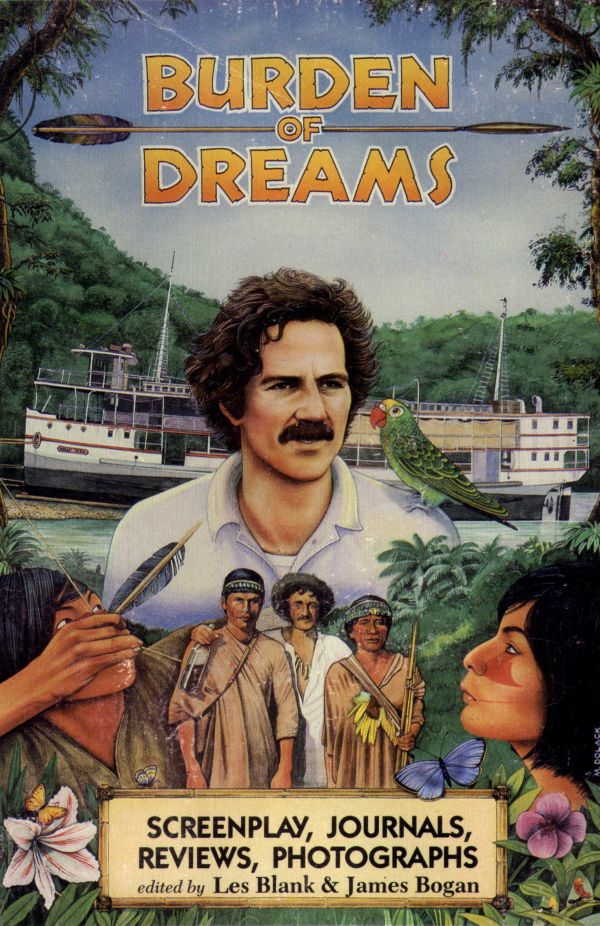 This is a project that was certainly cursed from the beginning, and there’s something appropriate about the film’s subject being a man attempting to do something ludicrous and borderline insane – drag a ship over a mountain – because Herzog’s persistence can only be admired. From the get-go, there were issues with the natives, and the initial location had to be abandoned, with locals burning the camp to the ground as the crew pulled out. Burden also includes footage from the original version, which started filming over a year later with new locations, and starred Jason Robards as Fitzcarraldo, with (of all people) Mick Jagger as his sidekick. After five weeks shooting, almost half the movie was already in the can, when Robards came down with amoebic dysentery and had to return to the United States, where his doctor forbade him from returning. While Herzog tried desperately to find another lead, Jagger had to return to his Rolling Stones related duties, and his character ended up being written out entirely.
This is a project that was certainly cursed from the beginning, and there’s something appropriate about the film’s subject being a man attempting to do something ludicrous and borderline insane – drag a ship over a mountain – because Herzog’s persistence can only be admired. From the get-go, there were issues with the natives, and the initial location had to be abandoned, with locals burning the camp to the ground as the crew pulled out. Burden also includes footage from the original version, which started filming over a year later with new locations, and starred Jason Robards as Fitzcarraldo, with (of all people) Mick Jagger as his sidekick. After five weeks shooting, almost half the movie was already in the can, when Robards came down with amoebic dysentery and had to return to the United States, where his doctor forbade him from returning. While Herzog tried desperately to find another lead, Jagger had to return to his Rolling Stones related duties, and his character ended up being written out entirely.